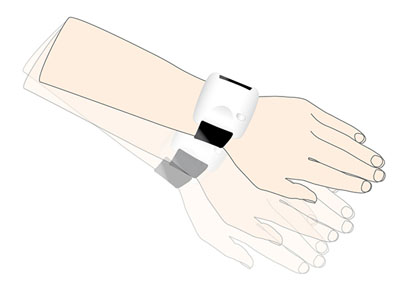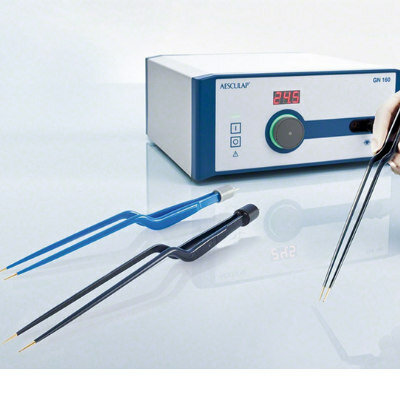Noninvasive Device Monitors Parkinson’s Patients, Informs Treatment Decisions
|
By HospiMedica International staff writers Posted on 05 May 2016 |

Image: The Parkinson\'s KinetiGraph (PKG) Data Logger records movement data, functioning as a companion-monitoring tool that doctors can use to better inform their treatment & management decisions for patients with movement disorders, such as Parkinson’s Disease. The device also reminds the patient to register when they have taken their medication (Photo courtesy of Global Kinetics).
An innovative new companion monitoring tool worn like a wristwatch could help provide more effective therapy for patients with Parkinson's disease and other disorders that affect movement by better informing the decisions of physicians who treat them.
A Cedars-Sinai (Los Angeles, CA, USA) research team is one of the first in the nation to test the Personal KinetiGraph (PKG) data logger, which tracks the movements of Parkinson's patients every 2 minutes over a period of 6–10 days. The information enables neurologists to generate reports showing the fluctuations of Parkinson's symptoms throughout the day and the timing of when patients take their medication.
Michele Tagliati, MD, Cedars-Sinai, said the device could be a game-changer for treatment of patients with advanced Parkinson's disease by providing an objective record of movement fluctuations. Such information can enhance doctors' understanding of the nature and progression of the brain disorder. The device also vibrates to remind patients to press a button indicating that they have taken their medication.
"This technology could help us as physicians better inform our patients of treatment options, such as when to have an aggressive therapy like deep brain stimulation," said Dr. Tagliati, "A more refined approach to treating the symptoms of the disease will ultimately lead to a better quality of life for our patients."
Currently, one of the biggest challenges neurologists face when managing Parkinson's patients is making treatment decisions based on relatively brief patient interactions and subjective patient reports about symptoms. "It's virtually impossible to make a well-informed treatment plan based on how patients feel they have been doing in the last three months, because often they don't remember," said Dr. Tagliati, "The PKG device provides a quantitative way to monitor and understand the fluctuations of movements in our patients when they are not in the office."
Dr. Tagliati and colleague Echo Tan, MD, have sought to more fully understand the disease. After the US Food and Drug Administration (FDA) cleared the device in 2014, they launched a 60-patient clinical trial to study its effectiveness. The study includes patients from various stages of Parkinson's disease. Preliminary findings have been valuable. For example, one patient said his medication stopped working after three hours, whereas the report generated by the watch device showed that the drug hadn't worked at all. This information prompted Dr. Tan to change the patient's prescription.
"The watch works great," said a study patient, "It makes it more objective as opposed to subjective. Like the pain scale, for example. They ask you to rate your pain on a scale of 0 to 10, but my 5 might be your 9, or my 5 might be your 1."
Related Links:
Cedars-Sinai
Global Kinetics
A Cedars-Sinai (Los Angeles, CA, USA) research team is one of the first in the nation to test the Personal KinetiGraph (PKG) data logger, which tracks the movements of Parkinson's patients every 2 minutes over a period of 6–10 days. The information enables neurologists to generate reports showing the fluctuations of Parkinson's symptoms throughout the day and the timing of when patients take their medication.
Michele Tagliati, MD, Cedars-Sinai, said the device could be a game-changer for treatment of patients with advanced Parkinson's disease by providing an objective record of movement fluctuations. Such information can enhance doctors' understanding of the nature and progression of the brain disorder. The device also vibrates to remind patients to press a button indicating that they have taken their medication.
"This technology could help us as physicians better inform our patients of treatment options, such as when to have an aggressive therapy like deep brain stimulation," said Dr. Tagliati, "A more refined approach to treating the symptoms of the disease will ultimately lead to a better quality of life for our patients."
Currently, one of the biggest challenges neurologists face when managing Parkinson's patients is making treatment decisions based on relatively brief patient interactions and subjective patient reports about symptoms. "It's virtually impossible to make a well-informed treatment plan based on how patients feel they have been doing in the last three months, because often they don't remember," said Dr. Tagliati, "The PKG device provides a quantitative way to monitor and understand the fluctuations of movements in our patients when they are not in the office."
Dr. Tagliati and colleague Echo Tan, MD, have sought to more fully understand the disease. After the US Food and Drug Administration (FDA) cleared the device in 2014, they launched a 60-patient clinical trial to study its effectiveness. The study includes patients from various stages of Parkinson's disease. Preliminary findings have been valuable. For example, one patient said his medication stopped working after three hours, whereas the report generated by the watch device showed that the drug hadn't worked at all. This information prompted Dr. Tan to change the patient's prescription.
"The watch works great," said a study patient, "It makes it more objective as opposed to subjective. Like the pain scale, for example. They ask you to rate your pain on a scale of 0 to 10, but my 5 might be your 9, or my 5 might be your 1."
Related Links:
Cedars-Sinai
Global Kinetics
Latest Critical Care News
- CPR Guidelines Updated for Pediatric and Neonatal Emergency Care and Resuscitation
- Ingestible Capsule Monitors Intestinal Inflammation
- Wireless Implantable Sensor Enables Continuous Endoleak Monitoring
- Pulse Oximeter Index Offers Non-Invasive Guides for Fluid Therapy
- Wearable Patch for Early Skin Cancer Detection to Reduce Unnecessary Biopsies
- 'Universal' Kidney to Match Any Blood Type
- Light-Based Technology to Measure Brain Blood Flow Could Diagnose Stroke and TBI
- AI Heart Attack Risk Assessment Tool Outperforms Existing Methods
- Smartphone Imaging System Enables Early Oral Cancer Detection
- Swallowable Pill-Sized Bioprinter Treats GI Tract Injuries

- Personalized Brain “Pacemakers” Could Help Patients with Hard-To-Treat Epilepsy
- Microscopic DNA Flower Robots to Enable Precision Medicine Delivery
- Origami Robots to Deliver Medicine Less Invasively and More Effectively
- Improved Cough-Detection Technology Aids Health Monitoring
- AI Identifies Children in ER Likely to Develop Sepsis Within 48 Hours
- New Radiofrequency Therapy Slows Glioblastoma Growth
Channels
Surgical Techniques
view channel
Robotic Assistant Delivers Ultra-Precision Injections with Rapid Setup Times
Age-related macular degeneration (AMD) is a leading cause of blindness worldwide, affecting nearly 200 million people, a figure expected to rise to 280 million by 2040. Current treatment involves doctors... Read more
Minimally Invasive Endoscopic Surgery Improves Severe Stroke Outcomes
Intracerebral hemorrhage, a type of stroke caused by bleeding deep within the brain, remains one of the most challenging neurological emergencies to treat. Accounting for about 15% of all strokes, it carries... Read morePatient Care
view channel
Revolutionary Automatic IV-Line Flushing Device to Enhance Infusion Care
More than 80% of in-hospital patients receive intravenous (IV) therapy. Every dose of IV medicine delivered in a small volume (<250 mL) infusion bag should be followed by subsequent flushing to ensure... Read more
VR Training Tool Combats Contamination of Portable Medical Equipment
Healthcare-associated infections (HAIs) impact one in every 31 patients, cause nearly 100,000 deaths each year, and cost USD 28.4 billion in direct medical expenses. Notably, up to 75% of these infections... Read more
Portable Biosensor Platform to Reduce Hospital-Acquired Infections
Approximately 4 million patients in the European Union acquire healthcare-associated infections (HAIs) or nosocomial infections each year, with around 37,000 deaths directly resulting from these infections,... Read moreFirst-Of-Its-Kind Portable Germicidal Light Technology Disinfects High-Touch Clinical Surfaces in Seconds
Reducing healthcare-acquired infections (HAIs) remains a pressing issue within global healthcare systems. In the United States alone, 1.7 million patients contract HAIs annually, leading to approximately... Read moreHealth IT
view channel
Printable Molecule-Selective Nanoparticles Enable Mass Production of Wearable Biosensors
The future of medicine is likely to focus on the personalization of healthcare—understanding exactly what an individual requires and delivering the appropriate combination of nutrients, metabolites, and... Read moreBusiness
view channel
Philips and Masimo Partner to Advance Patient Monitoring Measurement Technologies
Royal Philips (Amsterdam, Netherlands) and Masimo (Irvine, California, USA) have renewed their multi-year strategic collaboration, combining Philips’ expertise in patient monitoring with Masimo’s noninvasive... Read more
B. Braun Acquires Digital Microsurgery Company True Digital Surgery
The high-end microsurgery market in neurosurgery, spine, and ENT is undergoing a significant transformation. Traditional analog microscopes are giving way to digital exoscopes, which provide improved visualization,... Read more
CMEF 2025 to Promote Holistic and High-Quality Development of Medical and Health Industry
The 92nd China International Medical Equipment Fair (CMEF 2025) Autumn Exhibition is scheduled to be held from September 26 to 29 at the China Import and Export Fair Complex (Canton Fair Complex) in Guangzhou.... Read more














